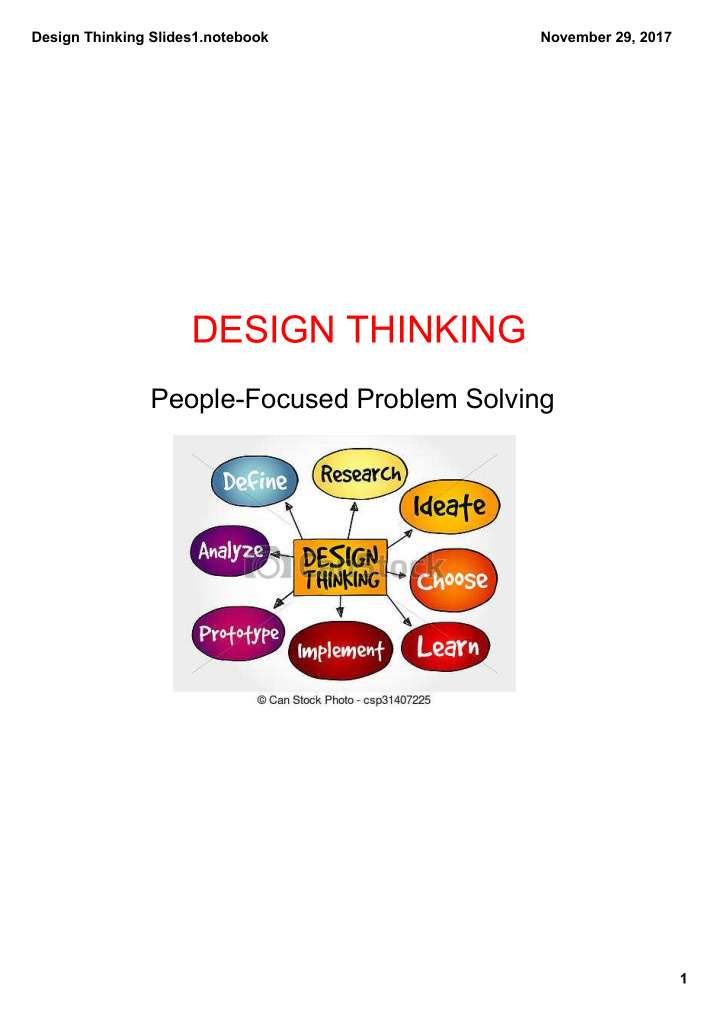



Design Thinking Slides1.notebook November 29, 2017 DESIGN THINKING PeopleFocused Problem Solving 1
Design Thinking Slides1.notebook November 29, 2017 STEP 1 IMMERSION Jump into the problem: Get on the dance floor! Gather as much information as you can What are people, DOING, SAYING, THINKING, and FEELING? Find out "why" by observing and asking open ended questions Be a traveler/alien Immerse at the extremes 2
Design Thinking Slides1.notebook November 29, 2017 neat pretty stuffed sporty messy dirty lots of water bottles busy unorganized careless empty unique organized blue pink decorated trashy full fun clean simple small colorful lots of papers half empty, half full 3
Design Thinking Slides1.notebook November 29, 2017 What did I think? What did I see? 4
Design Thinking Slides1.notebook November 29, 2017 many books and looseleaf papers with no where to go Different sections it's not very decorative a lot of blue useful crayon box a bit messy a lot of objects messed up disorganized functional neat fine neat and organized bright artistic creative doesn't use the hooks you could put another shelf on top 5
Design Thinking Slides1.notebook November 29, 2017 OBJECTIVE Not influenced by personal feelings or opinions in considering facts SUBJECTIVE Based on or influenced by personal feelings or opinions 6
Design Thinking Slides1.notebook November 29, 2017 EMPATHY The ability to understand and share feelings of another 7
Design Thinking Slides1.notebook November 29, 2017 1) How did empathy play an important role in the design of the MRI machine? 2) Why do you think empathy is part of the design problem solving process? 8
Design Thinking Slides1.notebook November 29, 2017 STEP 2 FRAME Move from "the dance floor" to "the balcony" Gain some perspective Frame your challenge as an opportunity "How Might We...?" 9
Design Thinking Slides1.notebook November 29, 2017 Shopping Cart Challenge? HMW....? 10
Design Thinking Slides1.notebook November 29, 2017 MRI Machine Challenge HMW....? 11
Design Thinking Slides1.notebook November 29, 2017 STEP 3 IMAGINE Generate LOTS of solutions to our challenge Get creative and resourceful Don't edit! Cluster and label related ideas Take something off the table and ask many "What if....?" questions Play with constraints: "What if we had 1 million dollars?" "Enlighten trial and error, succeeds over the planning of the lone genius." "YES, AND..." 12
Design Thinking Slides1.notebook November 29, 2017 STEP 4 PROTOTYPE Pick an idea you are passionate about Create a rapid prototype: anything that helps experience the experience you imagined Just do it! Build, Test, Learn! Show, don't tell! Share prototypes and talk to the people in your community. This is a continuous process! 13
Design Thinking Slides1.notebook November 29, 2017 14
Design Thinking Slides1.notebook November 29, 2017 THE RULES : 1) Build the Tallest Freestanding Structure : The winning team is the one that has the tallest structure measured from the table top surface to the top of the marshmallow. That means the structure cannot be suspended from a higher structure, like a chair, ceiling or chandelier. 2) The Entire Marshmallow must be on top: The entire marshmallow needs to be on the top of the structure. Cutting or eating part of the marshmallow disqualifies the team. 3) Use as Much or as Little of the Kit : The team can use as many or as few of the 20 spaghetti sticks, as much or as little of the string or tape. The team cannot use the paper bag as part of their structure. 4) Break up the Spaghetti, String or Tape: Teams are free to break the spaghetti, cut up the tape and string to create new structures. 5) The Challenge Lasts 18 minutes : Teams cannot hold on to the structure when the time runs out. Those touching or supporting the structure at the end of the exercise will be disqualified. 15
Design Thinking Slides1.notebook November 29, 2017 TIME FOR REFLECTION: What was it like working in a group? Was there a leader in the group that directed? What were the strategies used? What happened when there was failure? 16
Design Thinking Slides1.notebook November 29, 2017 LESSONS LEARNED: Prototyping Matters! Find all Hidden Assumptions! 17
Design Thinking Slides1.notebook November 29, 2017 • Adapted from a presentation by Bryna Leider: JEP Yeshiva Day School Veteran’s Day Professional Development, November 2016 18
Recommend
More recommend